what a roll forming machine and die is?

Roll forming is a manufacturing process that involves shaping a continuous metal strip into a desired shape using a roll forming machine and die. A roll forming machine is a specialized piece of equipment that consists of a series of rollers arranged in a sequence that gradually bends and shapes the metal strip as it passes through. A die is a tool used to cut, shape, or form material to a specific shape and size.
During the roll forming process, the metal strip is fed through the machine, where it is gradually bent and formed into the desired shape by the rollers. The process is continuous, meaning that the material is formed in one continuous piece, which is then cut to length as needed.
Roll forming is an important process in the manufacturing industry because it allows for the production of complex shapes and designs with high precision and accuracy. It is widely used in the production of metal components for a variety of industries, including automotive, construction, and aerospace. Roll forming is a cost-effective alternative to other metal shaping processes, such as stamping or forging, because it requires less material waste and can be done at higher speeds.
A roll forming machine die is a specialized tool used in the roll forming process to shape and cut metal strips into specific shapes and sizes. The die consists of two main parts: the upper die, which is mounted on the top of the machine, and the lower die, which is mounted on the bottom of the machine.
The upper and lower dies work together to shape the metal strip as it passes through the roll forming machine. The metal strip is fed into the machine, where it is guided through a series of rollers that gradually bend and shape it. As the metal strip passes through the machine, it is cut and formed by the upper and lower dies to create the desired shape.
Roll forming machine dies can be custom-made to produce a wide range of shapes and sizes, making them versatile and useful in many different industries. Dies can be made from a variety of materials, including steel, carbide, and ceramic, depending on the specific needs of the application. The design of the die is critical to the success of the roll forming process, as it determines the accuracy and precision of the final product. Therefore, it is important to choose a reputable die manufacturer and ensure that the die is properly maintained to ensure the quality of the final product.
Importance of Accuracy and Precision when using a roll forming machine and die
-
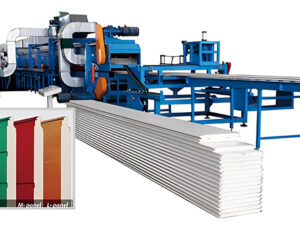 Garage door panel roll forming machine
Garage door panel roll forming machine -
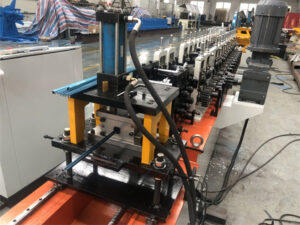 Stainless U Channel for Glass Window Supporter Machine
Stainless U Channel for Glass Window Supporter Machine -
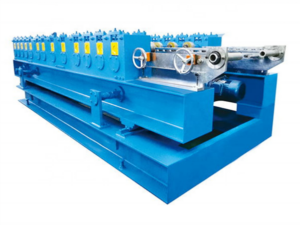 Shutters Box Series Forming Machines
Shutters Box Series Forming Machines -
 Awning Tube Roll forming machine
Awning Tube Roll forming machine -
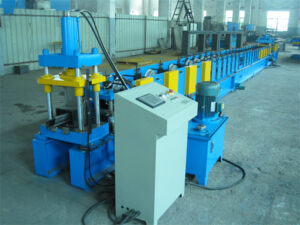 Metal door frame roll forming machine Double rebate
Metal door frame roll forming machine Double rebate -
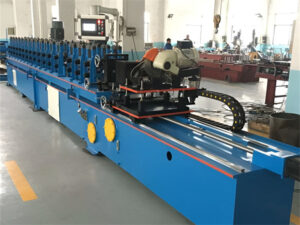 Shutter door octagonal pipe roll forming machine
Shutter door octagonal pipe roll forming machine -
 Galvanized Steel Guide Rail Roll Forming Making Machine
Galvanized Steel Guide Rail Roll Forming Making Machine -
 Windows & Doors Pu Foam Insulated Shutters Slat Roll Forming Machine
Windows & Doors Pu Foam Insulated Shutters Slat Roll Forming Machine -
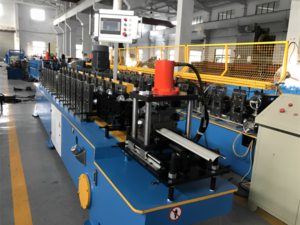 Metal Rolling Up shutter door roll forming machine
Metal Rolling Up shutter door roll forming machine
Accuracy and precision are critical in roll forming because they directly impact the quality of the final product.
Accuracy refers to the ability of the roll forming machine to produce parts that meet the specified dimensions and tolerances. Inaccuracies in the roll forming process can result in parts that are too large or too small, leading to fitment issues or rejection of the parts. This can result in wasted time and materials, increased costs, and reduced customer satisfaction.
Precision, on the other hand, refers to the consistency of the roll forming machine in producing parts within the specified tolerances. High precision ensures that parts are uniform and consistent in their dimensions and shape, which is essential in many applications. For example, in the automotive industry, precision is critical to ensure that parts fit together correctly and function properly.
In addition, accuracy and precision also play a crucial role in the aesthetics of the final product. Parts that are not accurately and precisely formed may have visual defects, such as warping or uneven edges, which can impact the overall appearance and quality of the final product. This can be especially important in industries such as consumer goods, where aesthetics are a key factor in the buying decision.
Overall, accuracy and precision are crucial in roll forming because they ensure that the final product meets the required specifications and quality standards. A high level of accuracy and precision results in reduced waste, increased productivity, and higher customer satisfaction, making it an important consideration in any roll forming operation.
Factors Affecting Accuracy and Precision when using a roll forming machine and die
There are several factors that can affect the accuracy and precision of the final product when using a roll forming machine and die. Some of the key factors are as follows:
Material Thickness: The thickness of the metal strip used in the roll forming process can have a significant impact on the accuracy and precision of the final product. Thicker materials may require more force to shape, which can affect the alignment of the rollers and result in variations in the final product. It is important to choose the appropriate material thickness for the specific application to ensure the accuracy and precision of the final product.
Tooling Design: The design of the tooling used in the roll forming process can also affect the accuracy and precision of the final product. The shape and dimensions of the tooling must be carefully selected to ensure that the metal strip is formed correctly and consistently. Proper tooling design can help reduce variations in the final product and improve the overall quality.
Alignment: Proper alignment of the roll forming machine and die is essential for achieving accurate and precise results. Misalignment can cause the metal strip to be formed incorrectly, resulting in parts that are out of tolerance. Regular maintenance and calibration of the roll forming machine and die are critical to ensuring proper alignment.
Setup: The setup of the roll forming machine and die can also affect the accuracy and precision of the final product. Proper setup includes ensuring that the machine is properly lubricated, the rollers are correctly adjusted, and the metal strip is fed through the machine at the appropriate speed. Any errors or mistakes in the setup process can result in variations in the final product.
Material Properties: The properties of the metal being formed, such as its strength and ductility, can also affect the accuracy and precision of the final product. Different metals may require different tooling designs and setup procedures to achieve accurate and precise results.
Overall, each of these factors can have a significant impact on the accuracy and precision of the final product when using a roll forming machine and die. It is important to carefully consider each of these factors and take the necessary steps to ensure that the roll forming process is set up correctly and optimized for the specific application.
Techniques to Ensure Accuracy and Precision when using a roll forming machine and die

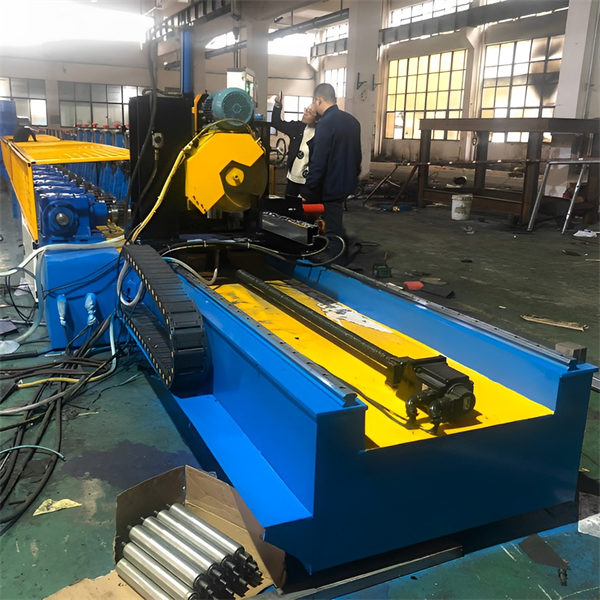
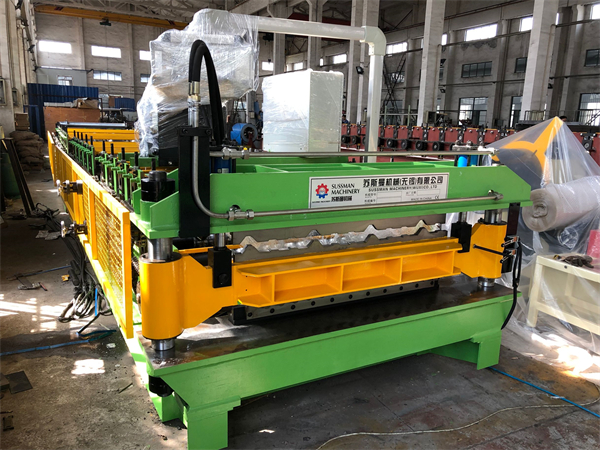
There are several techniques that can be used to ensure accuracy and precision in roll forming. Here are some of the most effective methods:
Laser Alignment Tools: Laser alignment tools can be used to ensure that the roll forming machine and die are properly aligned. These tools use lasers to project a straight line or a series of dots onto the machine and die, allowing the operator to quickly and accurately identify any misalignments. This technique ensures that the metal strip is fed through the machine in a consistent and accurate manner, improving the accuracy and precision of the final product.
Maintaining Proper Tooling: Proper maintenance and cleaning of the tooling used in the roll forming process is critical for achieving accurate and precise results. Regular inspection and replacement of worn or damaged tooling can help ensure that the metal strip is formed correctly and consistently. Proper tooling maintenance can also help prevent downtime due to equipment failure or malfunction.
Monitoring the Process: Regular monitoring of the roll forming process is essential for ensuring accuracy and precision. Operators should regularly check the dimensions and tolerances of the final product to ensure that they are within the specified range. Any variations or defects should be identified and corrected immediately to prevent the production of defective parts.
Advanced Control Systems: Advanced control systems, such as computerized numerical control (CNC) systems, can be used to improve the accuracy and precision of the roll forming process. These systems use digital technology to control the movement of the machine and the positioning of the rollers, ensuring that the metal strip is formed consistently and accurately. CNC systems also allow for easy adjustments to be made to the machine and die, ensuring that the process is optimized for the specific application.
Overall, these techniques can help ensure that the roll forming process is accurate and precise, resulting in high-quality parts that meet the required specifications and tolerances. By incorporating these methods into the roll forming process, manufacturers can improve efficiency, reduce waste, and increase customer satisfaction.
In summary, roll forming machines and dies are essential tools in the manufacturing industry, used to shape and cut metal strips into a wide range of shapes and sizes. To ensure accurate and precise results, manufacturers can use techniques such as laser alignment tools, proper tooling maintenance, process monitoring, and advanced control systems. By incorporating these methods into the roll forming process, manufacturers can improve efficiency, reduce waste, and increase customer satisfaction. At Suhang Machinery, we offer a wide range of roll forming machines and dies to meet the specific needs of our customers, and we are committed to providing high-quality products and services to help our customers achieve success in their manufacturing operations.
